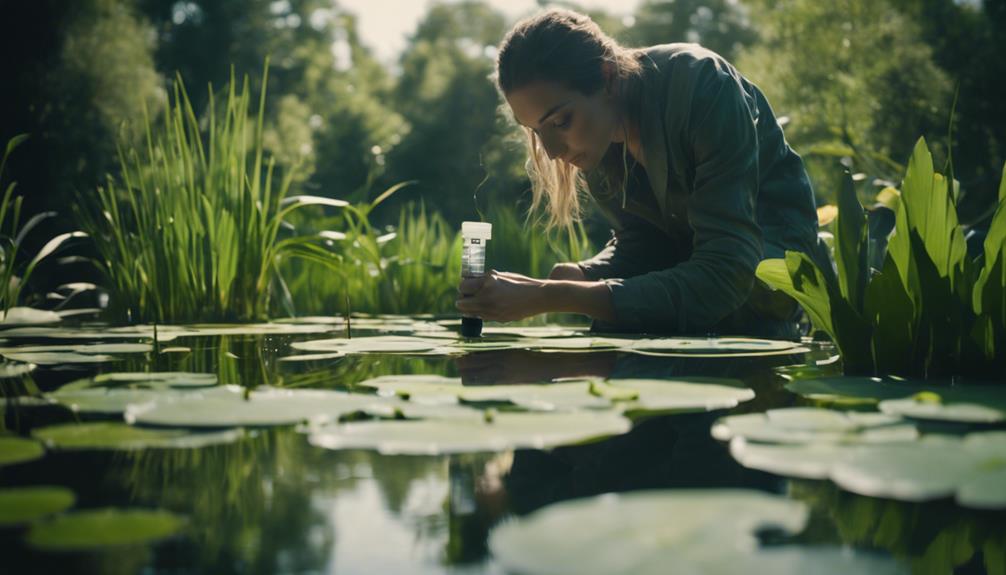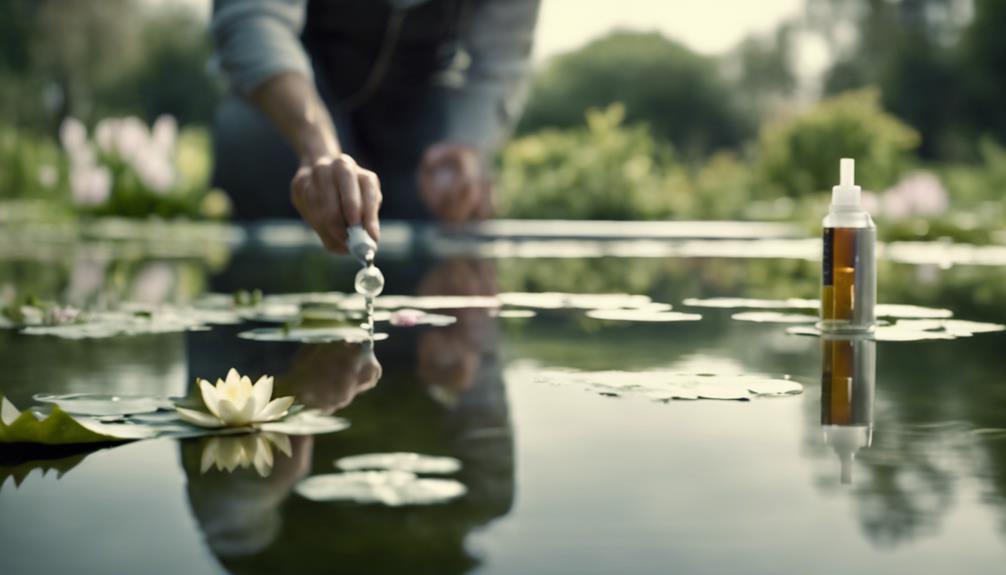You maintain a healthy and thriving pond ecosystem by regularly testing the water quality to guarantee balanced parameters that support aquatic life. Regular water testing provides valuable insights into your pond's water quality, allowing you to detect subtle changes and identify potential issues early. By monitoring parameters like pH, ammonia, nitrite, and nitrate levels, you can take prompt corrective action to prevent detrimental effects on your aquatic life. By doing so, you'll be well on your way to achieving crystal-clear water clarity and health, and next, you'll want to explore the ideal strategies for maintaining a balanced ecosystem.
Table of Contents
Key Takeaways
- Regular water testing detects subtle changes in pond water quality, enabling early identification of potential issues and prompt corrective action.
- Balanced water parameters, including pH, ammonia, nitrite, and nitrate levels, are critical for a thriving pond ecosystem and aquatic life.
- Regular testing saves time, money, and stress by allowing for early detection and correction of water quality issues before they escalate.
- Ideal water parameters include oxygen levels between 6.0-18.0mg/L, pH between 7.5-8.5, and KH around 125ppm, with zero levels of ammonia and nitrite.
- Regular water changes, adding beneficial bacteria, and introducing aquatic plants are essential for maintaining crystal-clear water clarity and health.
Understanding Pond Water Parameters
You need to measure and monitor specific parameters to maintain a healthy and thriving pond ecosystem.
This is achieved through regular water testing, which provides valuable insights into your pond's water quality.
As a responsible pond owner, you want to guarantee your pond's water is safe and suitable for aquatic life.
To do this, you'll need to test for parameters such as pH, ammonia, nitrite, and nitrate levels.
These parameters are critical in maintaining a balanced ecosystem, as even slight deviations can have detrimental effects on your pond's inhabitants.
Identifying Water Quality Issues
Regular water testing helps detect subtle changes in pond water quality, allowing you to pinpoint issues before they escalate into more severe problems.
By monitoring pond water quality, you can identify potential issues early on, preventing them from becoming major concerns.
For instance, a slight increase in ammonia levels can indicate a buildup of decaying organic matter, which can lead to more severe water quality issues if left unchecked.
Similarly, a decrease in oxygen levels can signal an overgrowth of algae, which can deplete the pond's oxygen supply and harm aquatic life.
When you identify water quality issues, you can take prompt action to correct them.
This might involve adjusting the pond's circulation, adding beneficial bacteria to break down organic matter, or introducing plants that absorb excess nutrients.
By taking proactive measures, you can restore balance to your pond's ecosystem and maintain healthy water quality.
The Importance of Regular Testing

Monitoring pond water quality on a regular schedule is essential, as it allows for the early detection of subtle changes that can signal potential problems.
By testing your pond water regularly, you'll be able to identify issues before they escalate, saving you time, money, and stress in the long run.
Regular testing also helps you understand the dynamics of your pond's ecosystem, allowing you to make informed decisions about its maintenance and care.
You'll be able to track changes in water parameters such as pH, ammonia, and nitrite levels, which can indicate underlying issues.
For instance, a sudden spike in ammonia levels could signal an overabundance of decaying organic matter.
By catching this early, you can take corrective action to prevent a full-blown water quality crisis.
Regular testing also helps you optimize water treatments and adjustments, ensuring your pond remains a healthy and thriving environment for its inhabitants.
Maintaining a Balanced Ecosystem
One key to maintaining a balanced ecosystem is ensuring that your pond's biological, chemical, and physical components interact harmoniously.
You can achieve this balance by introducing aquatic plants, which absorb excess nutrients and provide shelter for beneficial microorganisms. These microorganisms, in turn, help break down organic matter and maintain water clarity.
A well-functioning filtration system is also essential in maintaining a balanced ecosystem. It removes debris and waste, preventing the buildup of toxic compounds. By doing so, it creates an environment where aquatic plants and microorganisms can thrive.
As you work to maintain a balanced ecosystem, remember that every component plays a significant role. By understanding how these components interact, you can make informed decisions to create a thriving pond environment.
Optimizing Water Clarity and Health

You can guarantee crystal-clear water clarity and health by testing your pond water regularly, as this proactive approach allows you to detect and correct issues promptly.
By doing so, you'll be able to maintain ideal water parameters, which is necessary for a balanced pond ecosystem. Ideal water parameters include oxygen levels between 6.0-18.0mg/L, pH between 7.5-8.5, and KH around 125ppm.
Additionally, you should aim to keep ammonia and nitrite levels at 0ppm and nitrate levels below 20ppm.
To keep your pond thriving, regular water changes, adding beneficial bacteria, introducing aquatic plants, and avoiding overfeeding are imperative.
Monitoring water temperature is also imperative, as it affects aquatic life and water quality.
By taking these steps, you'll be able to optimize water clarity and health, creating a welcoming environment for your aquatic friends.
Frequently Asked Questions
How to Test Pond Water for Quality?
You'll want to collect a water sample from your pond, then send it to a laboratory for analysis, where experts will test for parameters like pH, ammonia, and nitrite levels, providing you with a detailed picture of your pond's water quality.
How to Improve Water Clarity in a Pond?
'Like a revitalizing breeze, you can revitalize your pond's clarity by installing aeration systems, promoting healthy aquatic life, and maintaining a balanced ecosystem – all key to achieving crystal-clear waters.'
How to Make Pond Water Crystal Clear?
You can achieve crystal-clear pond water by ensuring proper pond aeration, which helps prevent algae blooms, and maintaining a balanced ecosystem through regular water changes, beneficial bacteria, and aquatic plants.
How Do You Measure Pond Clarity?
You measure pond clarity by determining the Secchi depth, which indicates the distance you can see into the water, or by using Turbidity meters that provide a numerical value of the water's clarity based on suspended particles.
Conclusion
As you gaze out at your pond's tranquil surface, remember that beneath the calm exterior lies a delicate balance of parameters waiting to be upset.
Regular testing is the canary in the coal mine, warning you of impending water quality issues before they spiral out of control.
By staying vigilant, you'll discover the secret to a crystal-clear haven, teeming with life and energy – a true reflection of nature's harmony.

